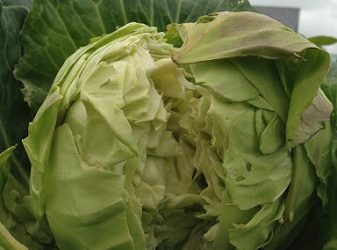Dealing with White Cabbage butterflies

White cabbage butterfly is large and strong-flying with a wingspan of 5.5cm. Both sexes are creamy-white, with a black head, thorax and abdomen. They have antennaes have white tips. Males have black tips on the forewings and a large spot on the hind wings.
Females have two large black spots on the forewings and two on the front margin of each hind wing. In the resting position, when the wings are closed, the underside of both sexes shows a hint of green with yellow speckling.
The caterpillars are nondescript with a yellowish-green base colour adorned with black blotches, a black head and backside. For protection, they are covered in small white or translucent hairs, and produce a chemical that makes them distasteful to predators such as birds.
Among the most destructive caterpillars, they prey on cabbages and Brussels sprouts, where they gather in numbers and cause extensive damage to leaves. They sometimes strip the leaf, leaving little more than a jagged stump. They also eat large sections of it, reducing the plant’s ability to photosynthesise and survive.
The female lays batches of up to 100 small, round yellow eggs on the underside of cabbage leaves and related plants. Two batches may be laid, one in May/June and the other in early August. In the season’s first batch, the black markings on the wings are more vivid.
Control measure
Insecticides
One of the most effective ways of dealing with these caterpillars is to remove them manually from the plants. This is valid in a small-scale operation, but chemical control is needed in commercial cultivation. Insecticidal soap and Neem-based insecticides are effective, but it is important to catch the pests before they damage the crop.
Natural predators
Due to the large number of caterpillars that gather on a cabbage, it is doubtful whether an integrated pest management programme alone is enough to control them in a large-scale operation. However, a number of insects prey on Pieris brassicae. These include Tachinid flies and several species of potter/mason wasps of the Eumenidae family and parasitic wasps such as Pteromalus puparum.
Also known as chalcid wasps, they are 3mm to 4mm long, and blackish in colour with distinctive ‘elbowed’ antennae. The female lays its eggs on an adult caterpillar ready to embark on the pupa (chrysalis) stage. The wasp’s grub feeds on the host caterpillar and when ready to emerge, it exits through a hole it chews in the chrysalis.


